Special Report
Places a COVID-19 Recession Will Likely Hit Hardest
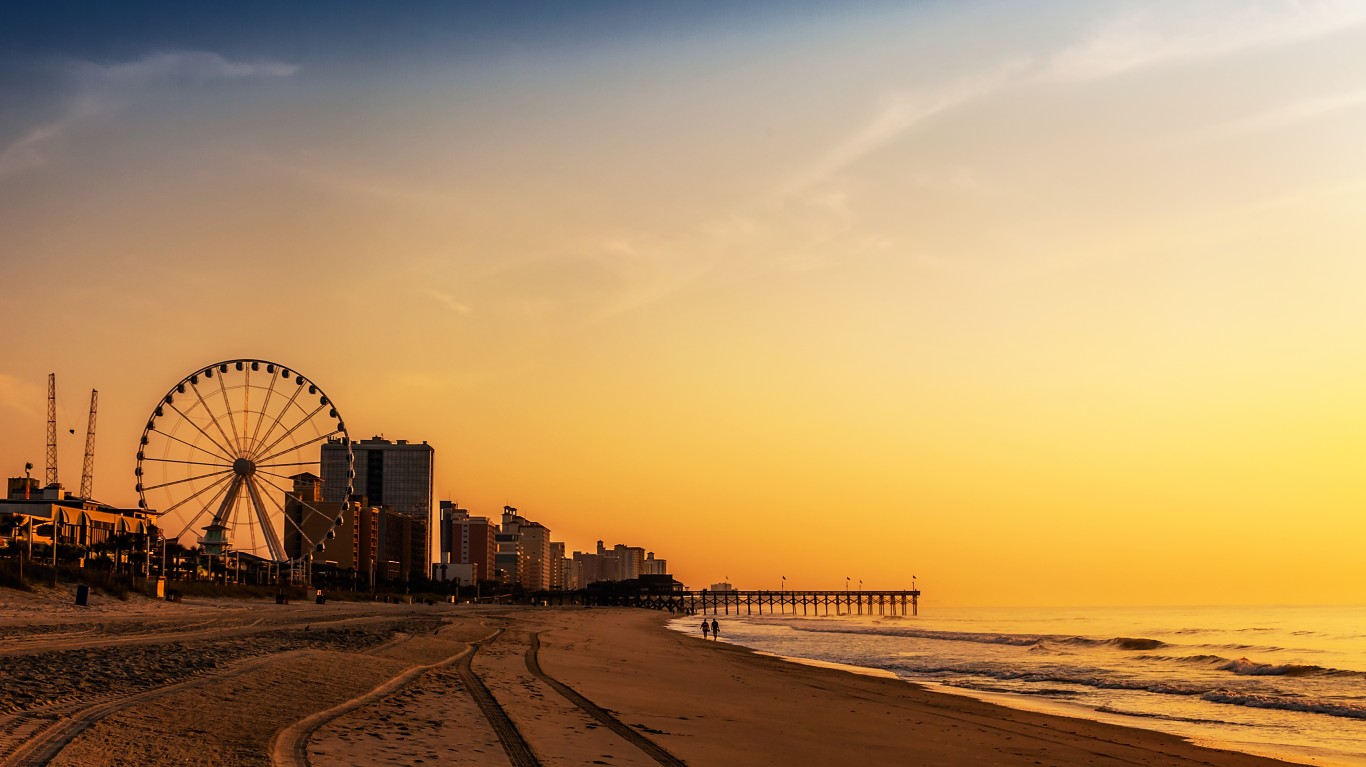
Published:

The coronavirus pandemic is a public crisis of historic proportions, threatening the health and economic stability of millions of Americans. With the April jobs report looming, economists are predicting the single largest monthly unemployment spike in U.S. history, as jobless claims have surged every week since President Donald Trump declared a national emergency in mid-March.
While no corner of the country will be spared the imminent economic downturn, certain areas will likely be far more affected in the coming weeks and months. The severity of the economic damage each city will sustain will likely depend on a multitude of factors. These factors include the type and size of businesses in the area as well as the coronavirus infection rate.
24/7 Wall St. created an index of these and other measures to determine which metropolitan areas the COVID-19 economic recession will likely hit hardest.
As nonessential travel has been suspended in much of the country and consumer confidence has diminished, industries such as oil and gas extraction, tourism, and transportation and warehousing will likely continue to bear the brunt of job losses in the coming weeks and months. These industries are economic pillars in the metro areas on this list.
Metro areas on this list also tend to have a high concentration of small businesses. Small businesses are at an elevated risk of permanent closure during the pandemic as they typically do not have the liquid capital of larger companies to stay afloat during prolonged closure. Establishments like bars and restaurants are particularly vulnerable. Here is a look at 35 popular restaurants that will not reopen after the pandemic.
Economic hardship will likely also be worse in areas with higher infection rates. In these places, consumers may be more reluctant to venture into public areas, and governments may be more likely to impose longer and stricter measures to contain the spread. Here is a state by state look at when COVID-19 restrictions will be lifted.
Click here to see the places a COVID-19 recession will likely hit hardest
Click here to read our methodology
25. Victoria, TX
> Pct. of workers in high-risk industries: 21.7%
> Businesses with fewer than 50 employees: 2,315
> COVID-19 cases as of May 6, 2020: 150 (150.8 per 100,000)
> Statewide stay-at-home order enacted: April 2, 2020
> Status of stay-at-home order as of May 6, 2020: Lifted
> Population: 99,047
The economy of the Victoria, Texas, metropolitan area is far more susceptible to long-term economic harm from the COVID-19 slowdown than most. The oil and gas industry is an economic pillar in Victoria — but it is also an industry that has been among the hardest hit during the pandemic. Plummeting global demand has led to a worldwide oil glut and cratering prices. Across the metro area, 6% of workers were employed in resource extraction before the COVID-19 crisis, about 12 times the national employment concentration.
[in-text-ad]
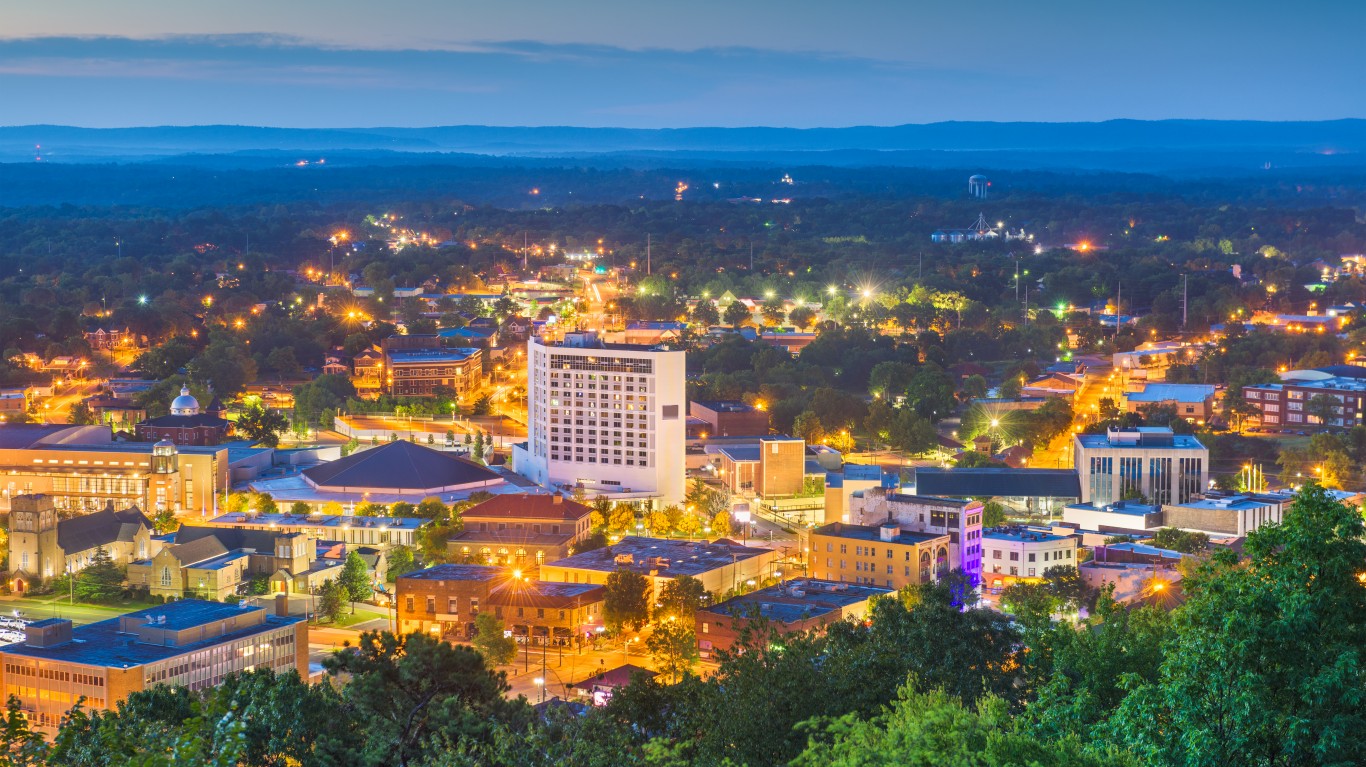
24. Hot Springs, AR
> Pct. of workers in high-risk industries: 21.9%
> Businesses with fewer than 50 employees: 2,653
> COVID-19 cases as of May 6, 2020: 117 (119.0 per 100,000)
> Statewide stay-at-home order enacted: N/A
> Status of stay-at-home order as of May 6, 2020: N/A
> Population: 99,154
In the Hot Springs, Arkansas, metropolitan area, an estimated 22% of all workers were employed in industries most susceptible to slowdown in the wake of the coronavirus pandemic, such as leisure and hospitality.
Though Arkansas is one of only a handful of states to have not issued a stay-at-home order, certain nonessential businesses closed or have been operating at reduced capacity — and in Hot Springs, the vast majority of them are small operations that typically do not have the same liquid capital as larger companies do to cover expenses during a sustained downturn. More than 2,600 businesses in Hot Springs operate with fewer than 50 employees.
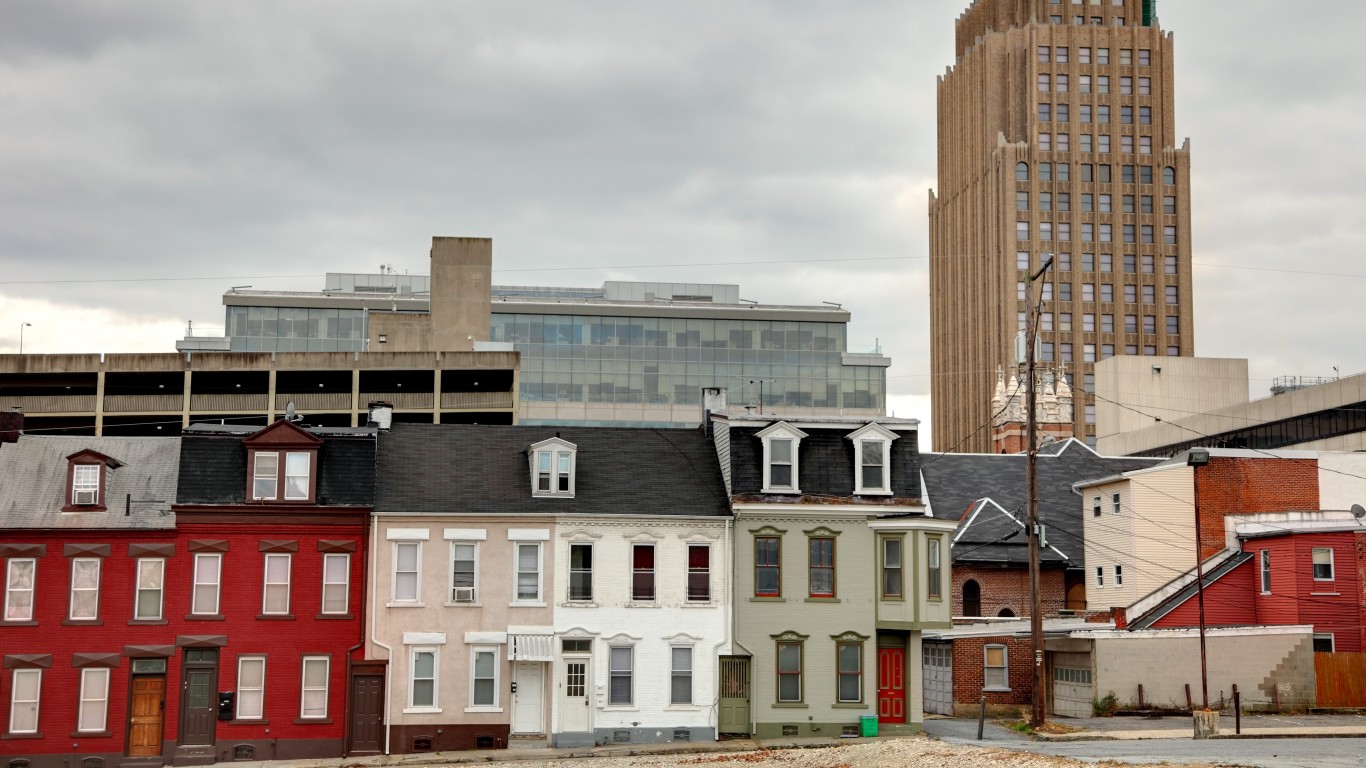
23. Allentown-Bethlehem-Easton, PA-NJ
> Pct. of workers in high-risk industries: 21.3%
> Businesses with fewer than 50 employees: 17,475
> COVID-19 cases as of May 6, 2020: 6,445 (772.2 per 100,000)
> Statewide stay-at-home order enacted: April 1, 2020
> Status of stay-at-home order as of May 6, 2020: In place
> Population: 842,913
The Allentown-Bethlehem-Easton metro area has been one of the hardest hit by the virus. There have been 772 confirmed infections and 38 fatalities for every 100,000 people in the metro area as of May 6 — well above the national rates of 368 and 20 per 100,000, respectively.
In an effort to reduce the spread, Pennsylvania imposed a statewide stay-at-home order on April 1. Though the order is currently slated to lift on May 8, many of the nearly 17,500 small businesses in the metropolitan area may not survive the period of reduced or nonexistent revenue. As of March — even before the stay-at-home order took effect — the area’s unemployment rate stood at 5.8%, up 1.1 percentage points from February.
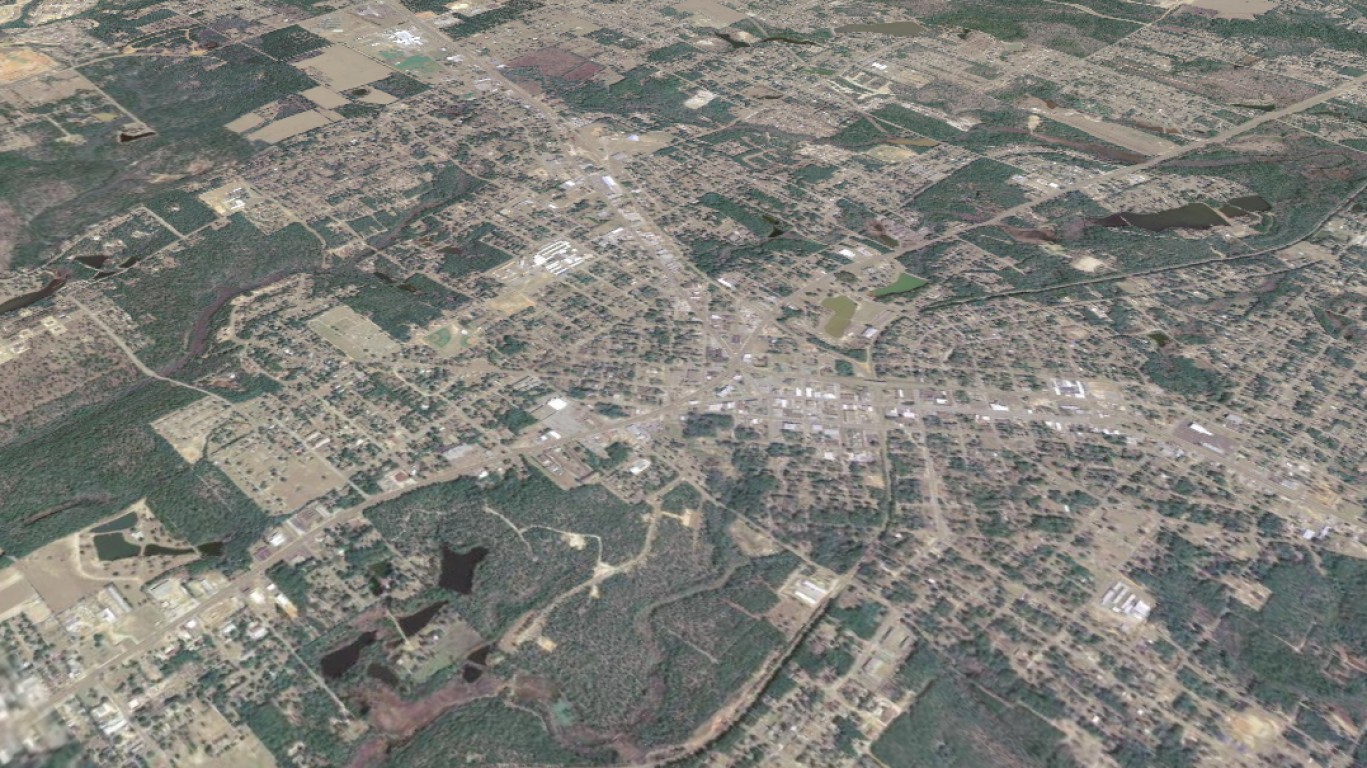
22. Crestview-Fort Walton Beach-Destin, FL
> Pct. of workers in high-risk industries: 22.8%
> Businesses with fewer than 50 employees: 7,461
> COVID-19 cases as of May 6, 2020: 211 (79.1 per 100,000)
> Statewide stay-at-home order enacted: April 3, 2020
> Status of stay-at-home order as of May 6, 2020: Lifted
> Population: 278,644
Crestview-Fort Walton Beach-Destin sits along the Gulf of Mexico in Florida’s panhandle. Like many coastal Florida cities, the Crestview area economy depends heavily on tourism — an industry being devastated as hundreds of millions of Americans have been under strict stay-at-home orders. About one in every five workers in the metro area were employed in the leisure and hospitality industry prior to the COVID-19 crisis.
The state of Florida implemented a stay-at-home order on April 3 and lifted it for most places on May 4. Though the shutdown did not last as long as it did in most other states, it will likely still be a long time before businesses return to normal. Currently, stores and restaurants in the state can only operate at 25% capacity.
[in-text-ad-2]
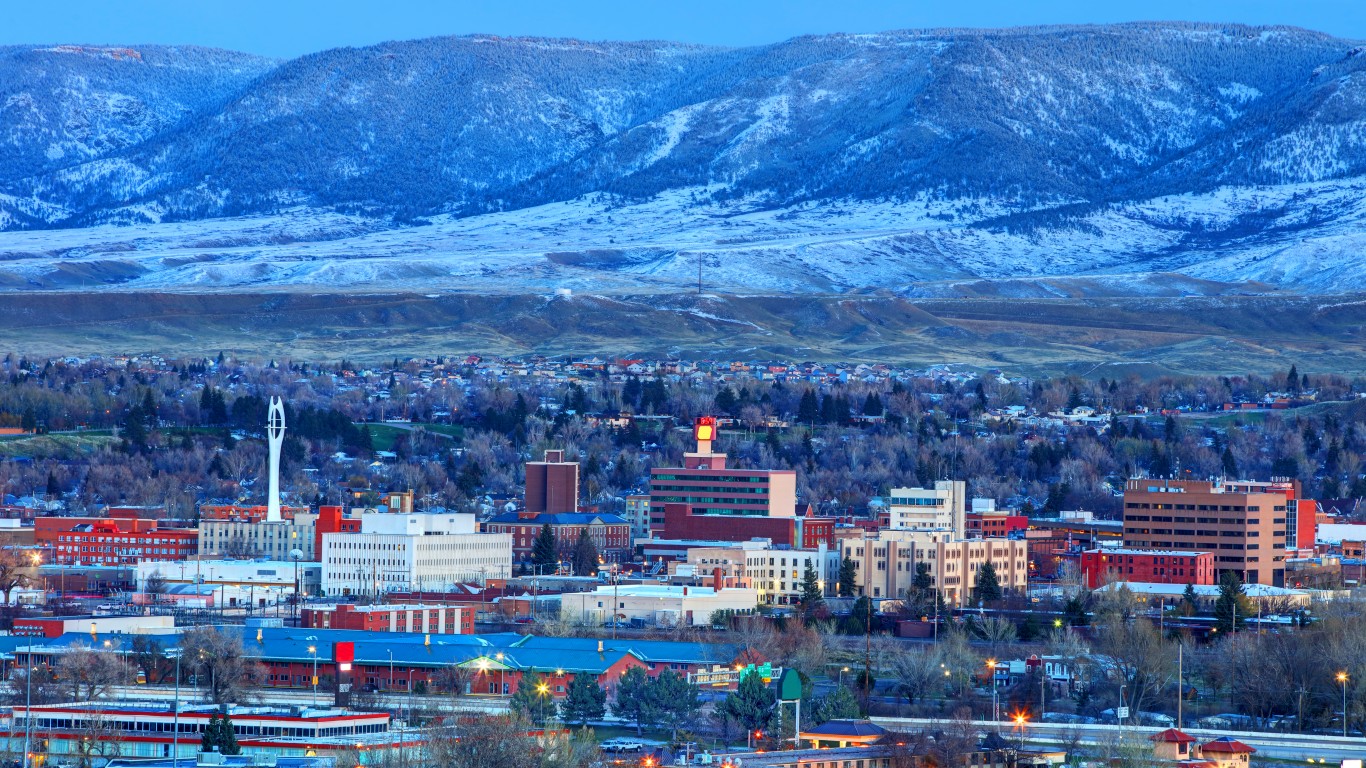
21. Casper, WY
> Pct. of workers in high-risk industries: 23.6%
> Businesses with fewer than 50 employees: 2,863
> COVID-19 cases as of May 6, 2020: 38 (47.1 per 100,000)
> Statewide stay-at-home order enacted: N/A
> Status of stay-at-home order as of May 6, 2020: N/A
> Population: 79,115
Casper is one of a handful of mining-dependent economies suffering during the economic downturn caused by COVID-19. According to the Bureau of Labor Statistics, 7.1% of Casper’s workforce is employed in the mining, quarrying, and oil and gas extraction sector, the fifth largest share of any metro area. Including other industries, a total of 23.6% of employment in Casper is in industries identified by Moody’s as high-risk during the coronavirus pandemic.
Casper is also home to a large number of small businesses that may lack the cash on hand necessary to stay afloat during an economic downturn. Some 99.1% of business establishments in Casper have fewer than 100 employees, the second largest share of any metro area.
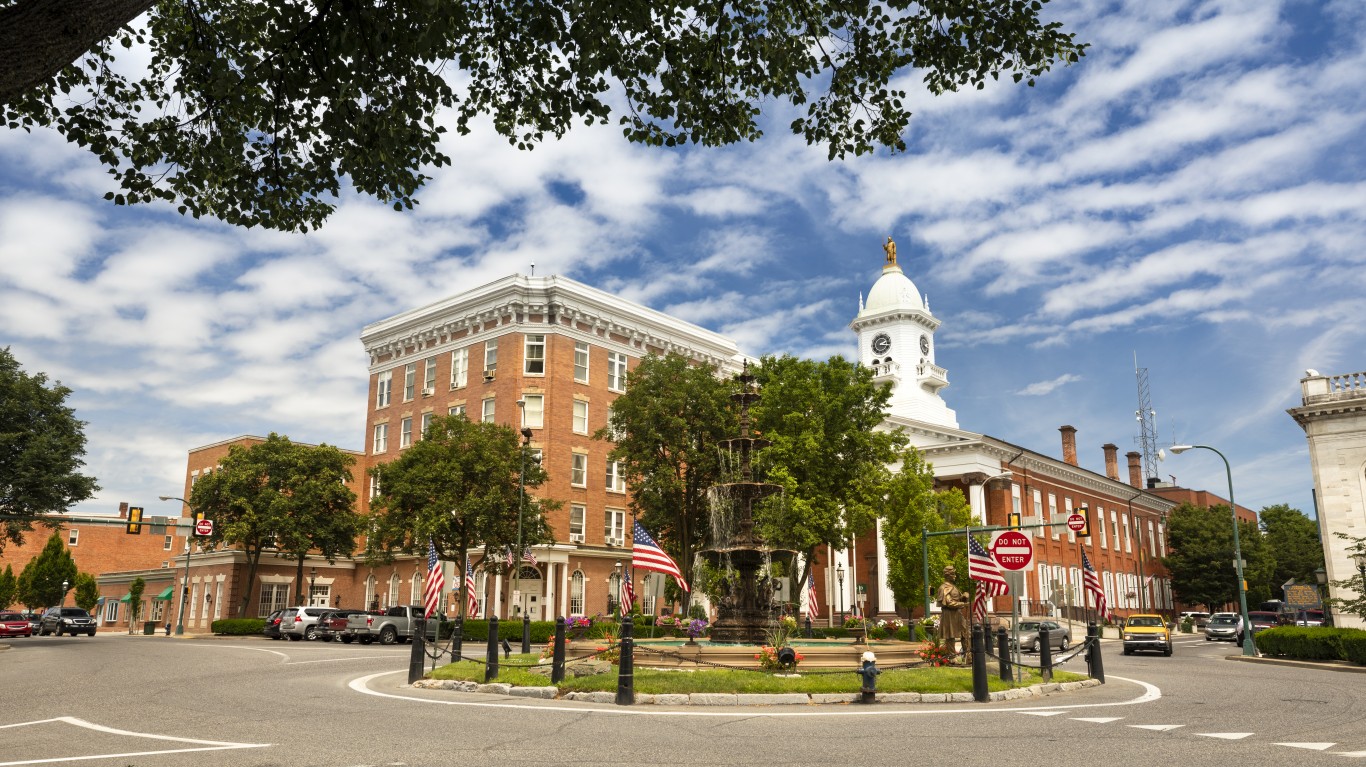
20. Chambersburg-Waynesboro, PA
> Pct. of workers in high-risk industries: 23.4%
> Businesses with fewer than 50 employees: 2,914
> COVID-19 cases as of May 6, 2020: 396 (257.6 per 100,000)
> Statewide stay-at-home order enacted: April 1, 2020
> Status of stay-at-home order as of May 6, 2020: In place
> Population: 154,835
Transportation and warehousing employs more than one in every 10 workers in the Chambersburg-Waynesboro metropolitan area — more than triple the comparable employment concentration nationwide. The industry, which tends to shadow broader economic trends, is expected to be one of the hardest hit by the effort to contain COVID-19.
The virus itself has been spreading relatively rapidly through the metro area in recent weeks. As of May 6, there were 396 confirmed cases of COVID-19 in the area, a more than 160% increase from two weeks prior.
[in-text-ad]
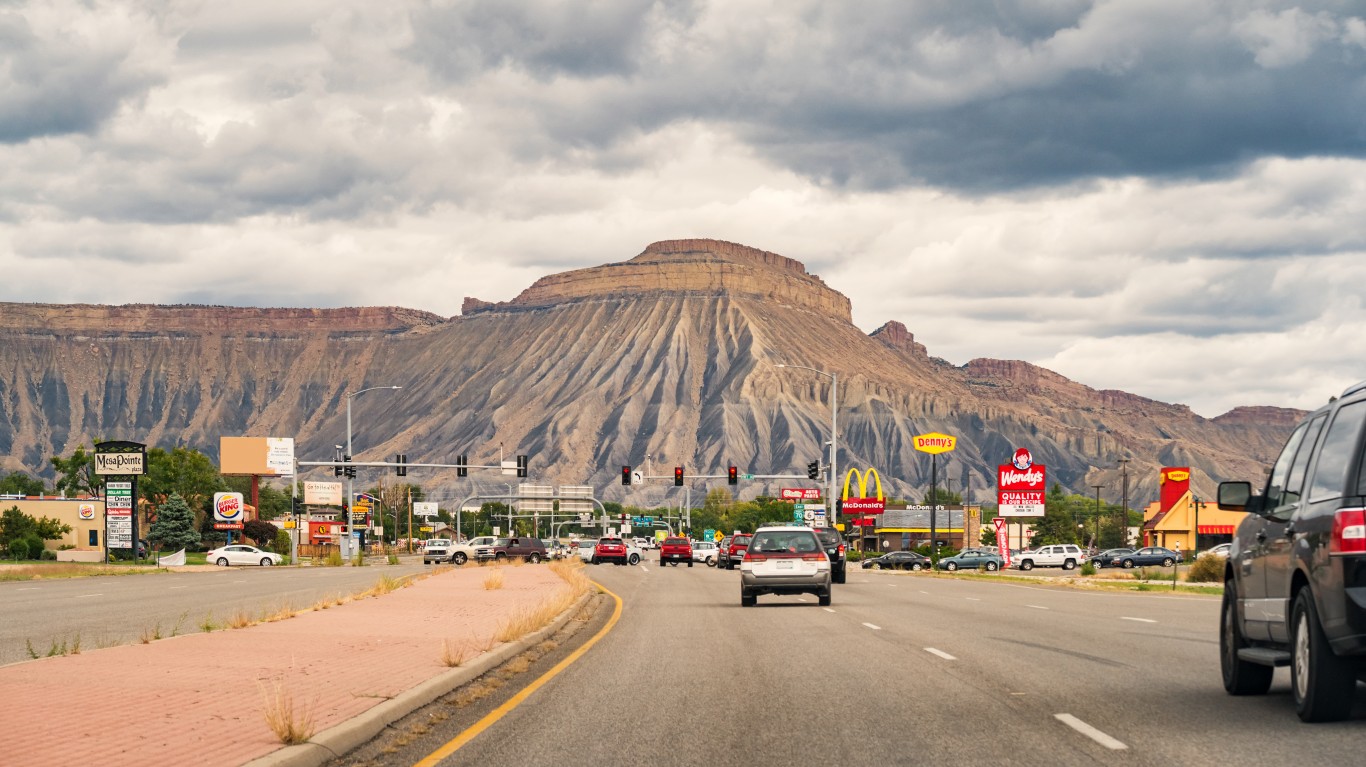
19. Grand Junction, CO
> Pct. of workers in high-risk industries: 21.0%
> Businesses with fewer than 50 employees: 4,271
> COVID-19 cases as of May 6, 2020: 46 (30.7 per 100,000)
> Statewide stay-at-home order enacted: March 26, 2020
> Status of stay-at-home order as of May 6, 2020: Rolled back to high risk Groups
> Population: 153,207
The Grand Junction metro area, located in west-central Colorado, is heavily dependent on resource extraction. Mining, quarrying, and oil and gas extraction — one of the hardest hit industries by the near nationwide shutdown of nonessential travel — accounts for nearly 4% of all area jobs, many times greater than the national concentration.
Though Colorado did not impose a stay-at-home order until late March, the statewide unemployment rate that month still rose 2.5 percentage points from February to 5.7%.
The state’s order was rolled back on April 26 and now only applies to residents at increased risk of serious complications from COVID-19.
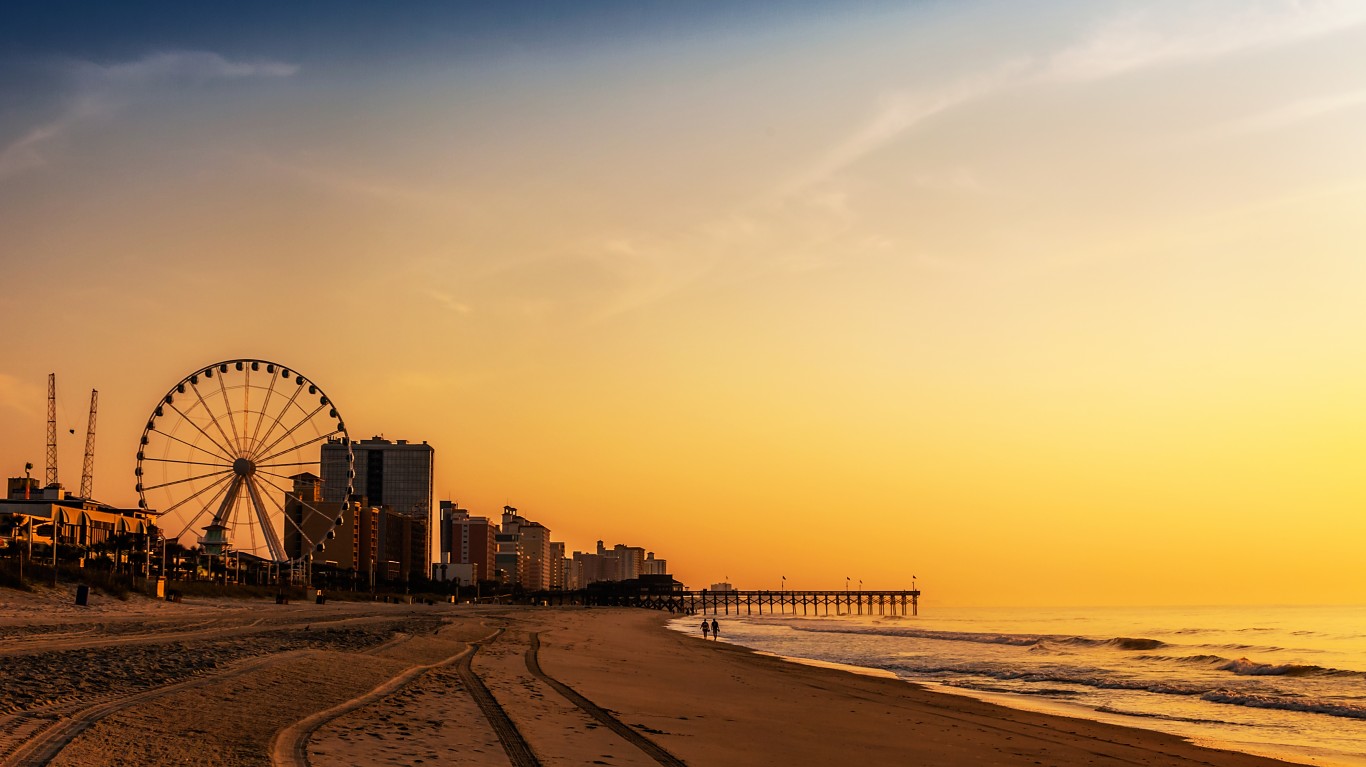
18. Myrtle Beach-Conway-North Myrtle Beach, SC-NC
> Pct. of workers in high-risk industries: 28.6%
> Businesses with fewer than 50 employees: 11,089
> COVID-19 cases as of May 6, 2020: 286 (63.9 per 100,000)
> Statewide stay-at-home order enacted: N/A
> Status of stay-at-home order as of May 6, 2020: Lifted
> Population: 480,891
Myrtle Beach is one of the most popular summer tourist destinations in the Southeast, with over 20 million annual visitors. Some 26.4% of workers in the Myrtle Beach metro area are employed in the leisure and hospitality sector, the fifth largest share of any city nationwide. Many tourism-dependent businesses are also likely to struggle, however, as safety precautions related to the novel coronavirus stall travel and consumer activity around the country.
South Carolina instituted a statewide stay-at-home order on April 7, approximately one month after the state’s first confirmed COVID-19 case. And while the order in South Carolina expired on May 4, major metro areas like Charlotte, Wilmington, and Greensboro, North Carolina, as well as Washington, D.C., and New York — the top five feeder cities for Myrtle Beach tourism in terms of credit card spending — are still under statewide lockdown orders.

17. Barnstable Town, MA
> Pct. of workers in high-risk industries: 22.4%
> Businesses with fewer than 50 employees: 8,457
> COVID-19 cases as of May 6, 2020: 969 (453.5 per 100,000)
> Statewide stay-at-home order enacted: March 24, 2020
> Status of stay-at-home order as of May 6, 2020: In place
> Population: 213,413
The Barnstable Town metro area, which makes up the entirety of Massachusetts’ Cape Cod, like many coastal U.S. cities depends heavily on tourism. The leisure and hospitality industry employs about one in every five workers in the metro area, nearly double the national employment concentration for the industry.
Of course, while not all industries are as exposed to the slowdown as tourism, every industry will be affected to some degree — and small businesses that lack the liquid capital of larger businesses will likely struggle to stay afloat during the economic downturn. In Barnstable, More than 97% of all businesses have fewer than 50 employees, nearly the largest share of any metropolitan area in the country.
[in-text-ad-2]
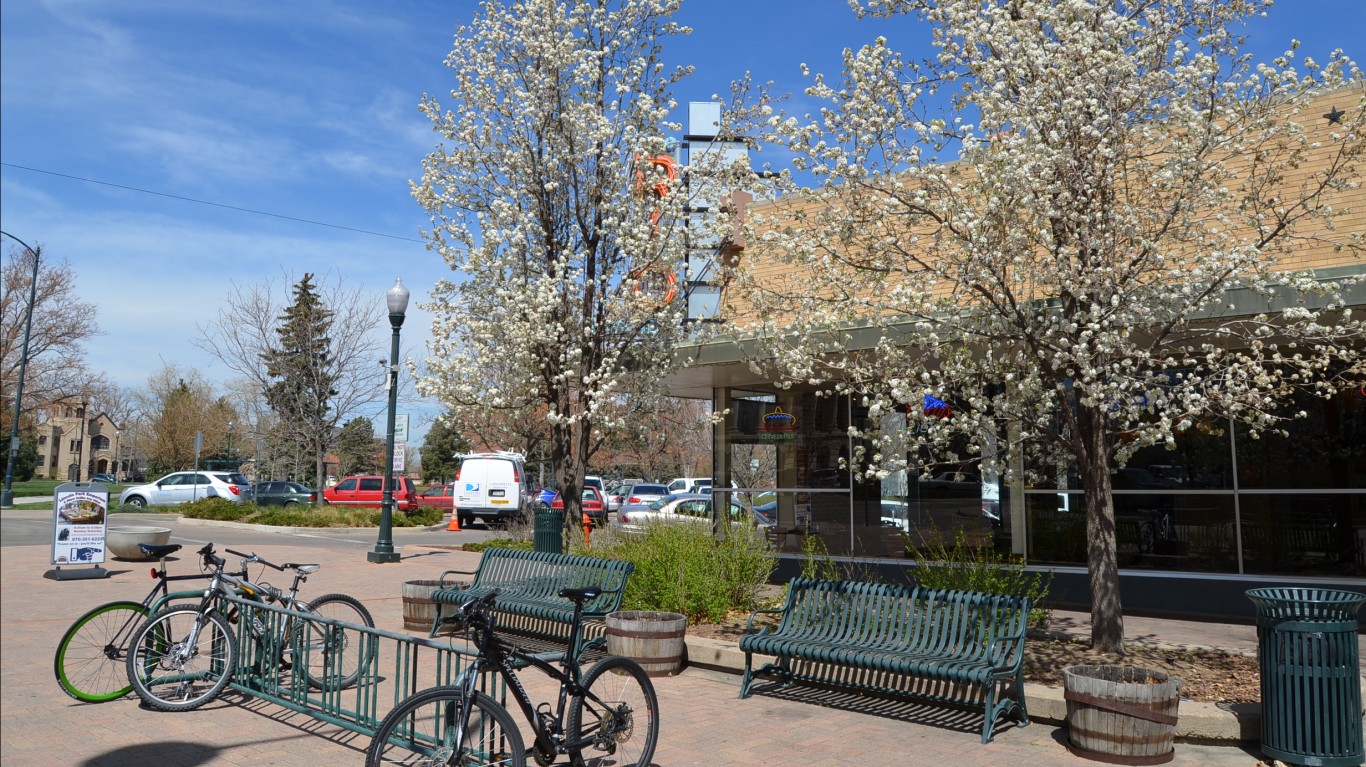
16. Greeley, CO
> Pct. of workers in high-risk industries: 20.8%
> Businesses with fewer than 50 employees: 6,002
> COVID-19 cases as of May 6, 2020: 1,955 (662.4 per 100,000)
> Statewide stay-at-home order enacted: March 26, 2020
> Status of stay-at-home order as of May 6, 2020: Rolled Back to High Risk Groups
> Population: 314,305
The economy in Greeley, Colorado, is heavily dependent on mining and oil and gas extraction — one of the hardest hit industries by the pandemic. Increased global production and plummeting demand have led to a worldwide oil glut and cratering prices. Across the metro area, nearly 8% of workers are employed in resource extraction, about 17 times the national employment concentration.
Though Colorado did not impose a stay-at-home order until late March, the statewide unemployment rate that month still rose by 1.9 percentage points from February to 4.3%.
The state’s order was rolled back on April 26 and now only applies to residents at increased risk of serious complications from COVID-19.
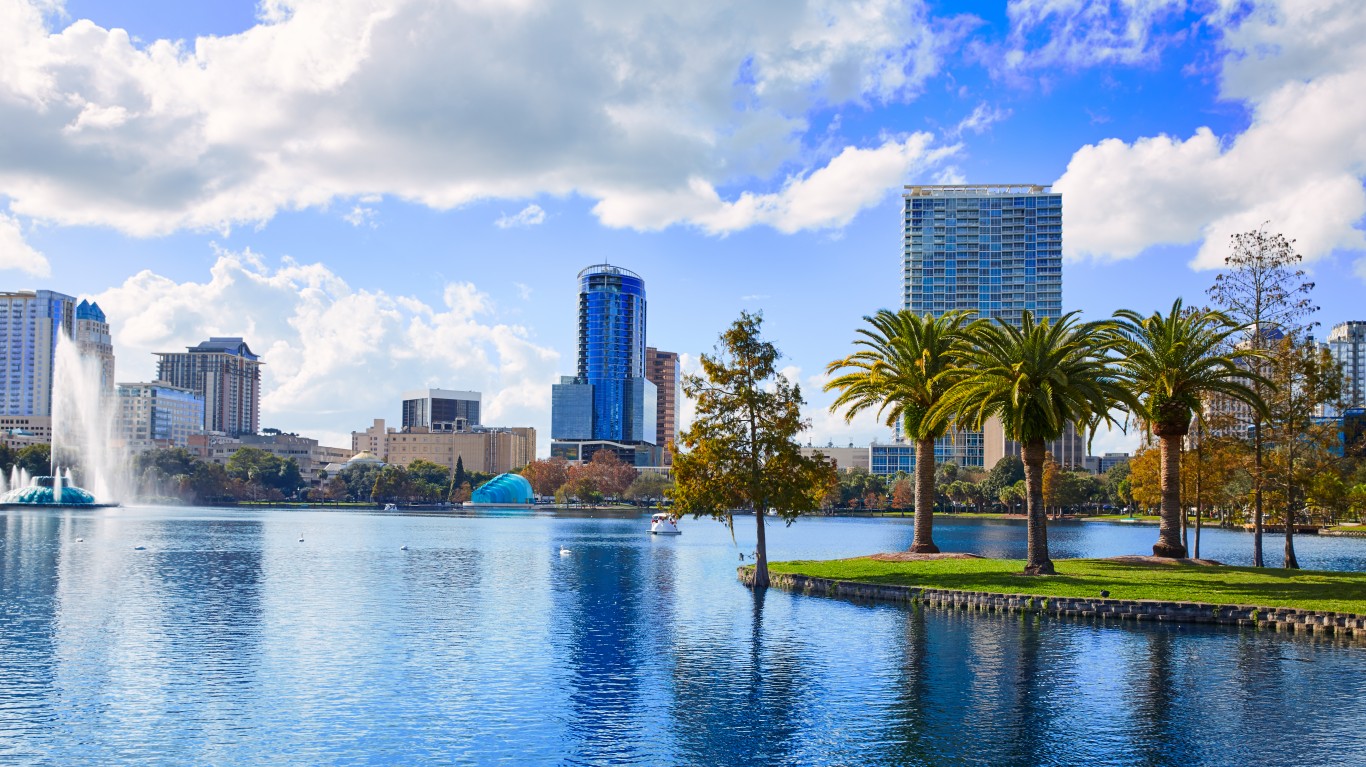
15. Orlando-Kissimmee-Sanford, FL
> Pct. of workers in high-risk industries: 28.1%
> Businesses with fewer than 50 employees: 61,312
> COVID-19 cases as of May 6, 2020: 2,598 (106.0 per 100,000)
> Statewide stay-at-home order enacted: April 3, 2020
> Status of stay-at-home order as of May 6, 2020: Lifted
> Population: 2.6 million
Home to a number of attractions — including Disney’s Magic Kingdom — the Orlando metropolitan area economy is based around tourism. Disney World alone drew in nearly 21 million visitors in 2018. Disney World shut down in mid-March, weeks before Florida issued a stay-at-home order, and it has yet to announce a reopening date — even though Florida lifted its statewide stay-at-home order on May 4. In mid-April the theme park furloughed 100,000 employees.
Even before Disney’s layoffs and Florida’s stay-at-home order, unemployment was on the rise in the Orlando area. As of March, the metro area’s unemployment rate stood at 4.2%, up 1.4 percentage points from February.
[in-text-ad]
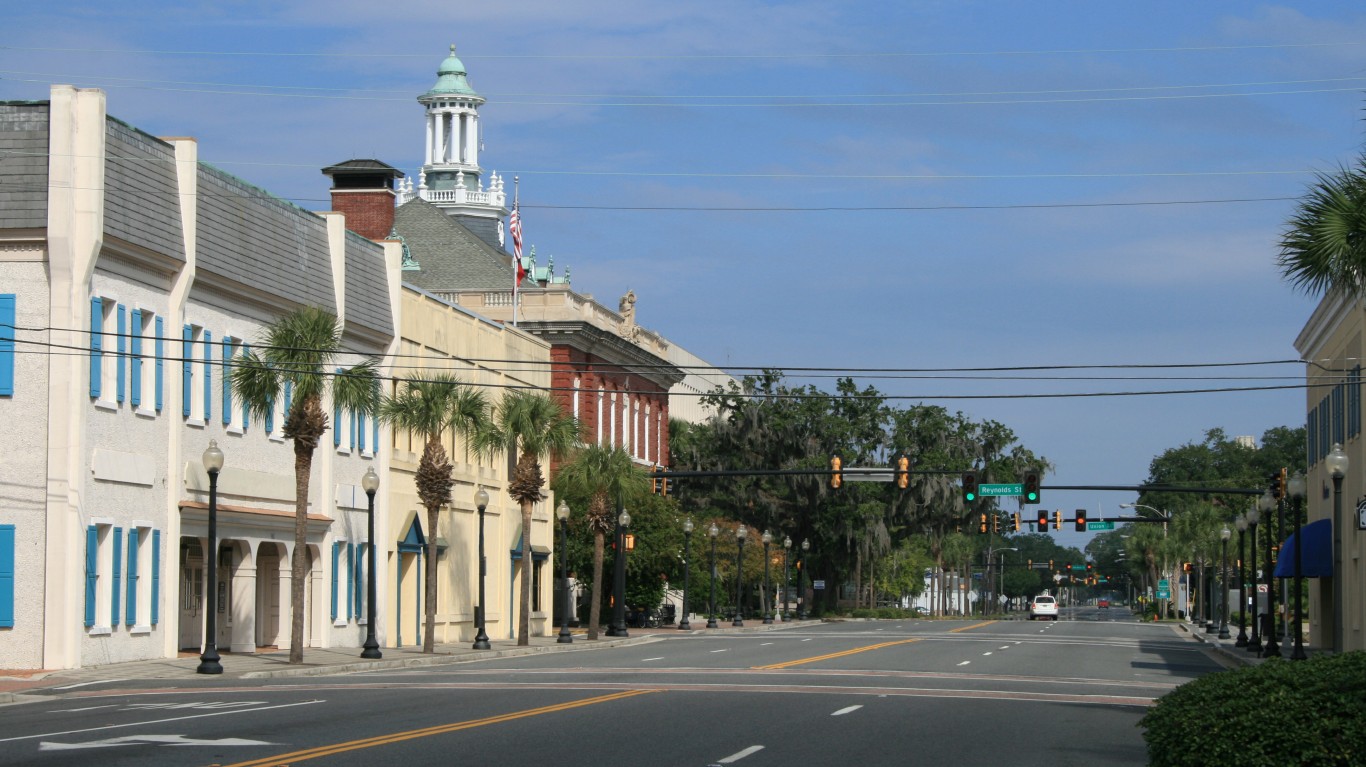
14. Brunswick, GA
> Pct. of workers in high-risk industries: 26.8%
> Businesses with fewer than 50 employees: 2,789
> COVID-19 cases as of May 6, 2020: 87 (74.6 per 100,000)
> Statewide stay-at-home order enacted: April 3, 2020
> Status of stay-at-home order as of May 6, 2020: Rolled back to high risk groups
> Population: 116,864
The Brunswick metro area is located in southeastern Georgia along the Atlantic coast. Few parts of the country are as dependent on tourism as Brunswick — and tourism is among the industries most affected by COVID-19 as nonessential travel has effectively ground to a halt. Nearly 22% of workers in the metro area were employed in the leisure and hospitality industry prior to the recession.
Despite concerns that lifting restrictions too early to restart the economy could backfire if cases of COVID-19 begin to surge again, Georgia’s stay-at-home order was in place for less than a month, lifted on April 30. Fortunately however, the number of confirmed cases in Brunswick climbed by a relatively low 16% over the two weeks leading up to May 6, a smaller increase than in most metro areas.
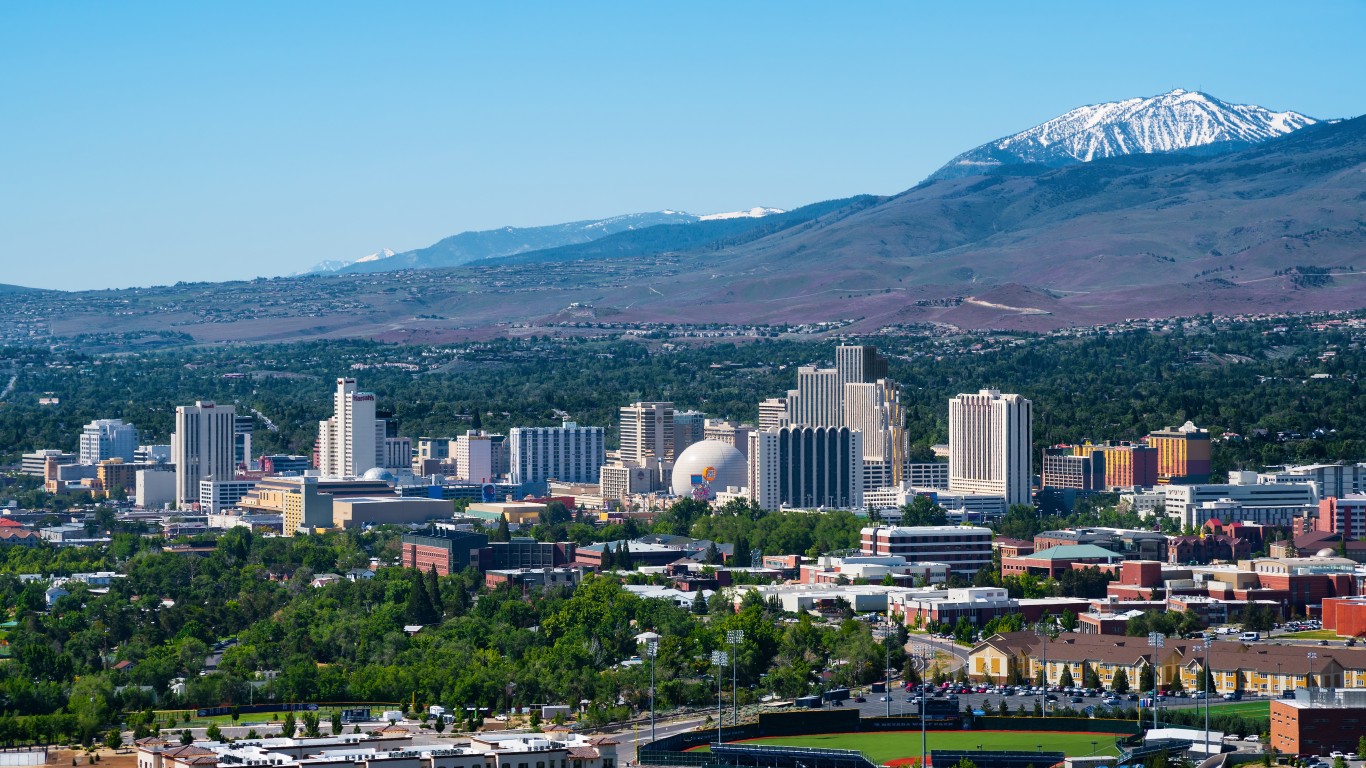
13. Reno, NV
> Pct. of workers in high-risk industries: 27.2%
> Businesses with fewer than 50 employees: 12,034
> COVID-19 cases as of May 6, 2020: 988 (217.4 per 100,000)
> Statewide stay-at-home order enacted: April 1, 2020
> Status of stay-at-home order as of May 6, 2020: In place
> Population: 471,265
Reno’s economy is especially exposed to a slowdown in the wake of COVID-19 due to the area’s high employment concentration in industries like transportation and warehousing, leisure and hospitality, and services — each of which is expected to report higher than average job losses. Prior to the COVID-19 crisis, fewer than one in every five workers in the metro area were employed in low-exposure industries like finance and utilities, compared to about half of all workers nationwide.
Nevada implemented a stay-at-home order on April 1 — but even before those restrictions took effect unemployment began climbing in Reno. As of March, 5.1% of workers in the metro area were unemployed, up 2.2 percentage points from February.
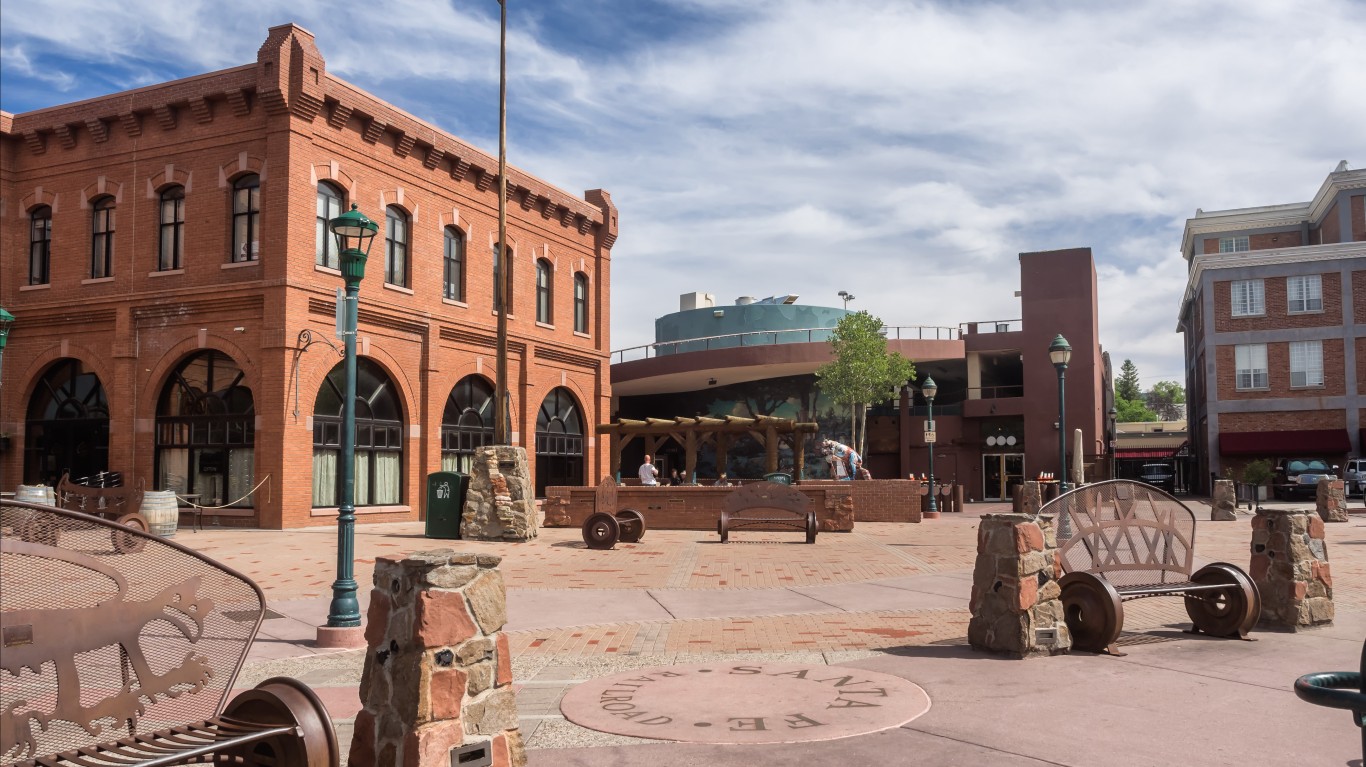
12. Flagstaff, AZ
> Pct. of workers in high-risk industries: 27.5%
> Businesses with fewer than 50 employees: 3,554
> COVID-19 cases as of May 6, 2020: 561 (400.1 per 100,000)
> Statewide stay-at-home order enacted: March 31, 2020
> Status of stay-at-home order as of May 6, 2020: In place
> Population: 142,854
A popular tourist destination for its climate and scenic beauty, the Flagstaff metro area is economically dependent on visitors from around the country and the world. As nonessential travel in the United States has slowed nearly to a halt in an effort to contain the spread of COVID-19, many of the more than 15,000 Flagstaff residents who work in leisure and hospitality face a far less certain future with regards to job security.
Even before Arizona’s statewide shelter-in-place order went into effect at the end of March, unemployment was surging in Flagstaff. The metro area’s March unemployment rate of 6.9% was 1.6 percentage points higher than it was in February.
[in-text-ad-2]
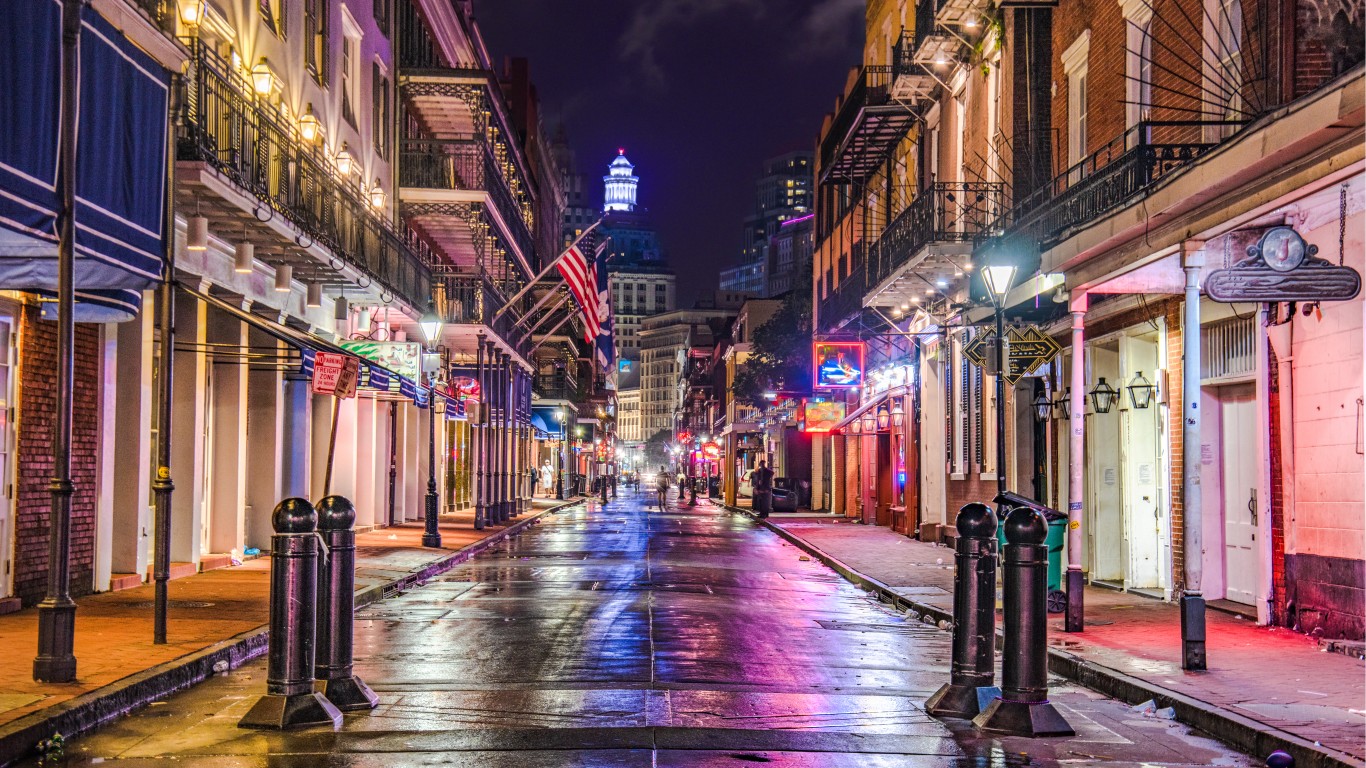
11. New Orleans-Metairie, LA
> Pct. of workers in high-risk industries: 22.2%
> Businesses with fewer than 50 employees: 29,336
> COVID-19 cases as of May 6, 2020: 16,743 (1,325.0 per 100,000)
> Statewide stay-at-home order enacted: March 23, 2020
> Status of stay-at-home order as of May 6, 2020: In place
> Population: 1.3 million
Few parts of the country have been hit as hard by the coronavirus as the New Orleans metro area. As of March 6, there were 1,325 cases of the virus and 89 deaths for every 100,000 people — well above the national rates of 368 cases and 20 deaths per 100,000. Partially as a result, the state has had one of the longest-standing shelter-in-place orders — going into effect on March 23 and not set to expire until May 15.
While shelter-in-place orders are critical for stopping the spread of the virus, they are harmful to business — particularly small businesses that are less likely to have cash to pay the bills during a prolonged closure. There are nearly 30,000 businesses in the New Orleans area with fewer than 50 employees.

10. Farmington, NM
> Pct. of workers in high-risk industries: 24.0%
> Businesses with fewer than 50 employees: 2,515
> COVID-19 cases as of May 6, 2020: 806 (632.4 per 100,000)
> Statewide stay-at-home order enacted: March 24, 2020
> Status of stay-at-home order as of May 6, 2020: In place
> Population: 125,043
Farmington, located in northwestern New Mexico, is one of several metro areas on this list heavily dependent on resource extraction. More than one in every 10 workers in the area were employed in the mining and oil and gas extraction industry prior to the COVID-19 crisis — more than 20 times the industry’s national employment concentration. The industry has been one of the hardest hit during the pandemic as increased global production and plummeting demand have resulted in an oil glut and cratering prices.
The COVID-19 infection and fatality rate has been far higher than average in the Farmington metro area. As of March 6, there were 632 cases of the virus and 49 deaths for every 100,000 people — well above the national rates of 368 cases and 20 deaths per 100,000.
[in-text-ad]
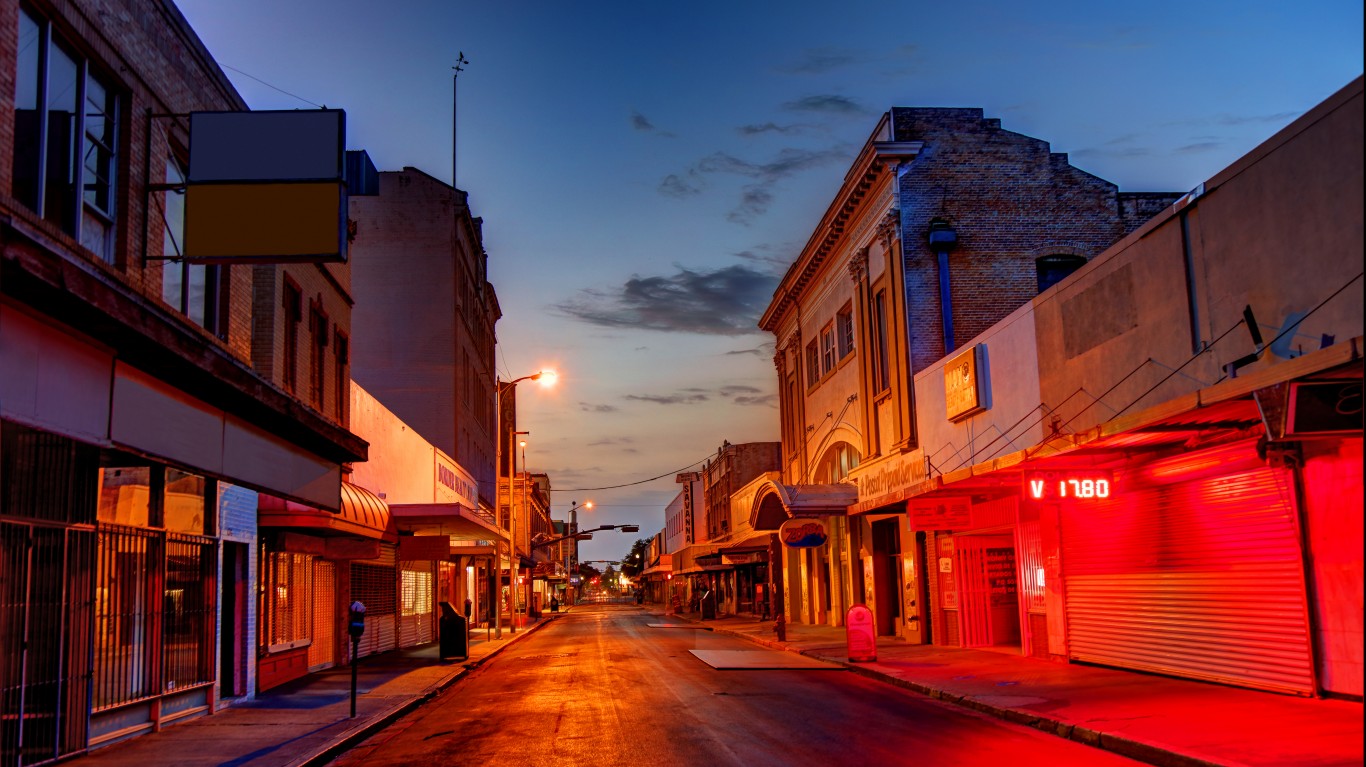
9. Laredo, TX
> Pct. of workers in high-risk industries: 31.0%
> Businesses with fewer than 50 employees: 5,125
> COVID-19 cases as of May 6, 2020: 396 (145.6 per 100,000)
> Statewide stay-at-home order enacted: April 2, 2020
> Status of stay-at-home order as of May 6, 2020: Lifted
> Population: 275,910
The transportation and warehousing industry is expected to see a considerable decline in demand from both commercial and consumer markets in the wake of COVID-19 — and no metro area has a larger share of its workforce employed in transportation and warehousing than Laredo, Texas. Nearly 15% of all area workers were employed in the industry prior to the COVID-19 crisis, more than quadruple the national concentration.
Jobless claims began climbing rapidly in Laredo even before Texas’s stay-at-home order went into effect on April 2. The area’s unemployment rate stood at 5.1% in March, up 1.3 percentage points from February.
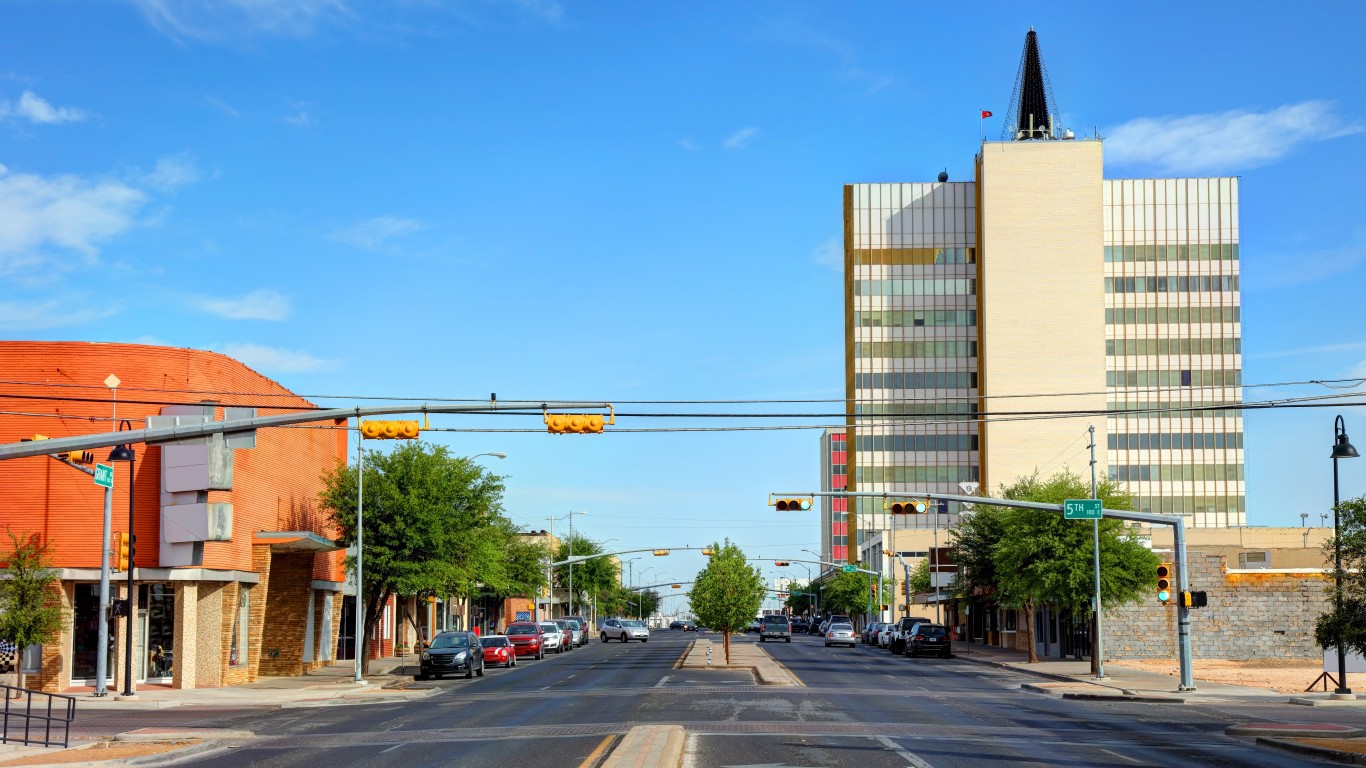
8. Odessa, TX
> Pct. of workers in high-risk industries: 33.1%
> Businesses with fewer than 50 employees: 3,422
> COVID-19 cases as of May 6, 2020: 84 (53.0 per 100,000)
> Statewide stay-at-home order enacted: April 2, 2020
> Status of stay-at-home order as of May 6, 2020: Lifted
> Population: 162,124
The west Texas metro area of Odessa is economically dependent on oil and gas extraction. The industry, which has been among the hardest hit during the pandemic, accounted for 16.1% of total employment in the area prior to COVID-19 — 35 times the national concentration. When accounting for other highly exposed industries such as transportation and warehousing and leisure and hospitality, nearly a third of all area workers are at greater than average risk of losing their jobs in the wake of the pandemic.
7. Houma-Thibodaux, LA
> Pct. of workers in high-risk industries: 29.5%
> Businesses with fewer than 50 employees: 4,332
> COVID-19 cases as of May 6, 2020: 1,155 (547.9 per 100,000)
> Statewide stay-at-home order enacted: March 23, 2020
> Status of stay-at-home order as of May 6, 2020: In place
> Population: 209,136
The industry makeup in the Houma-Thibodaux metro area, located in southeastern Louisiana along the Gulf Coast, makes it especially susceptible to severe economic fallout during the COVID-19 pandemic. Nearly 7% of workers in the metro area were employed in oil and gas extraction prior to COVID-19, an industry that has reported widespread layoffs amid an international price war and reduced demand during the pandemic. Industry leaders in the area penned a letter to the White House, requesting a reduction in the amount companies are charged to drill in the Gulf.
Additionally, more than one in 10 workers in the metro area were employed in the transportation and warehousing industry prior to the COVID-19 crisis, another sector of the economy projected to bear the brunt of the ongoing economic downturn.
[in-text-ad-2]
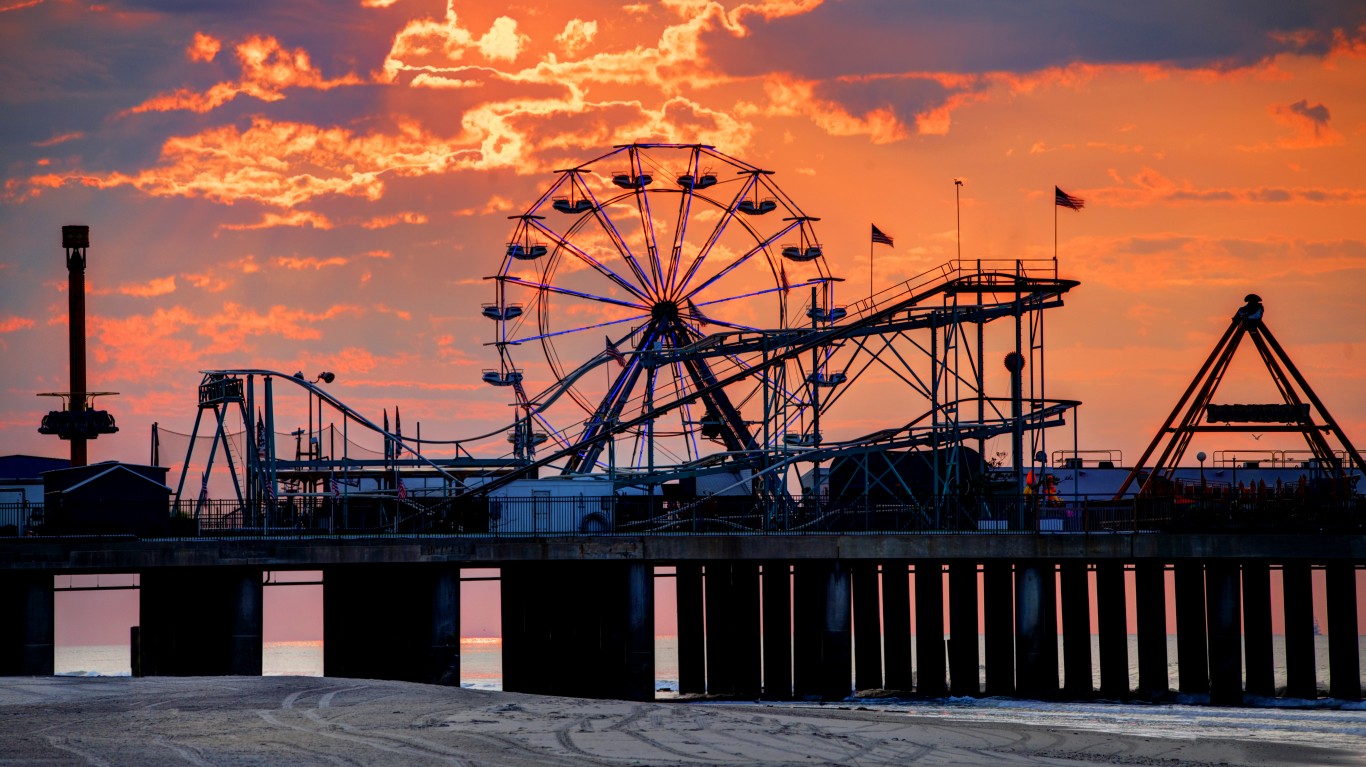
6. Atlantic City-Hammonton, NJ
> Pct. of workers in high-risk industries: 33.3%
> Businesses with fewer than 50 employees: 5,914
> COVID-19 cases as of May 6, 2020: 1,190 (443.1 per 100,000)
> Statewide stay-at-home order enacted: March 21, 2020
> Status of stay-at-home order as of May 6, 2020: In place
> Population: 265,429
New Jersey has one of the longest-standing stay-at-home orders of any state. The order went into effect on March 21, and Gov. Phil Murphy (D) has yet to indicate when he plans on lifting it. Despite the statewide order, cases of COVID-19 are surging in the Atlantic City metro area. As of May 6, there had been a total of 1,190 cases, a 136% increase from two weeks prior.
Atlantic City bills itself as “the seaside gaming and resort capital of the East Coast” and draws in about 27 million visitors per year. Like other parts of the country heavily dependent on tourism, unemployment will likely be a massive problem in the metro area in the coming months as nonessential travel has been effectively nonexistent during the pandemic. Prior to the crisis more than 31% of workers in the metro area worked in leisure and hospitality, nearly the largest share of any U.S. metro area.
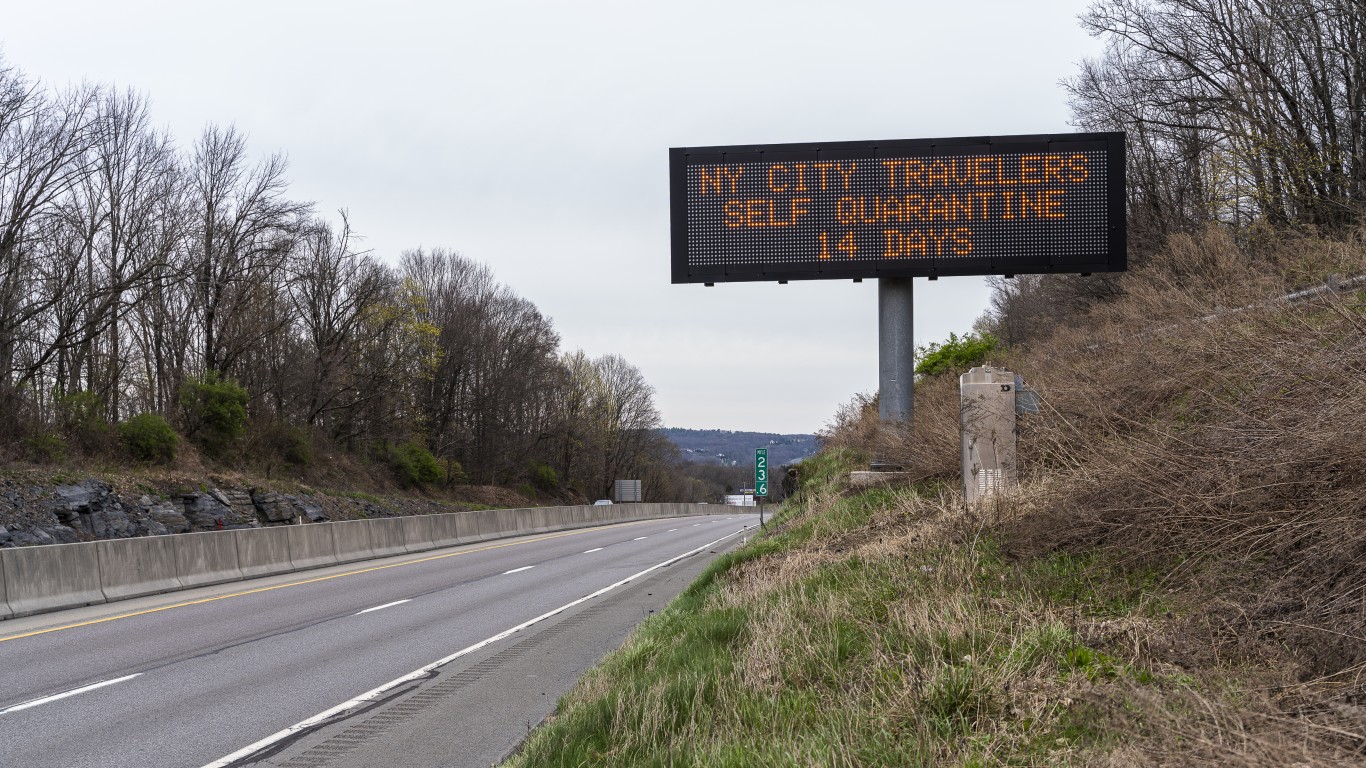
5. East Stroudsburg, PA
> Pct. of workers in high-risk industries: 27.1%
> Businesses with fewer than 50 employees: 3,233
> COVID-19 cases as of May 6, 2020: 1,186 (707.7 per 100,000)
> Statewide stay-at-home order enacted: April 1, 2020
> Status of stay-at-home order as of May 6, 2020: In place
> Population: 169,507
Located in the heart of the Pocono Mountain region, East Stroudsburg is one of Pennsylvania’s top tourist destinations, with an estimated 28 million visitors coming to enjoy the mountains every year. More than one in five workers in the East Stroudsburg metro area are employed in leisure and hospitality, a sector many economists are forecasting will be hardest hit by the slowdown in travel and consumer activity resulting from the COVID-19 pandemic. In total, 27.1% of workers in the metro area are employed in industries identified by Moody’s as high-risk, far more than the 17.7% national figure.
[in-text-ad]
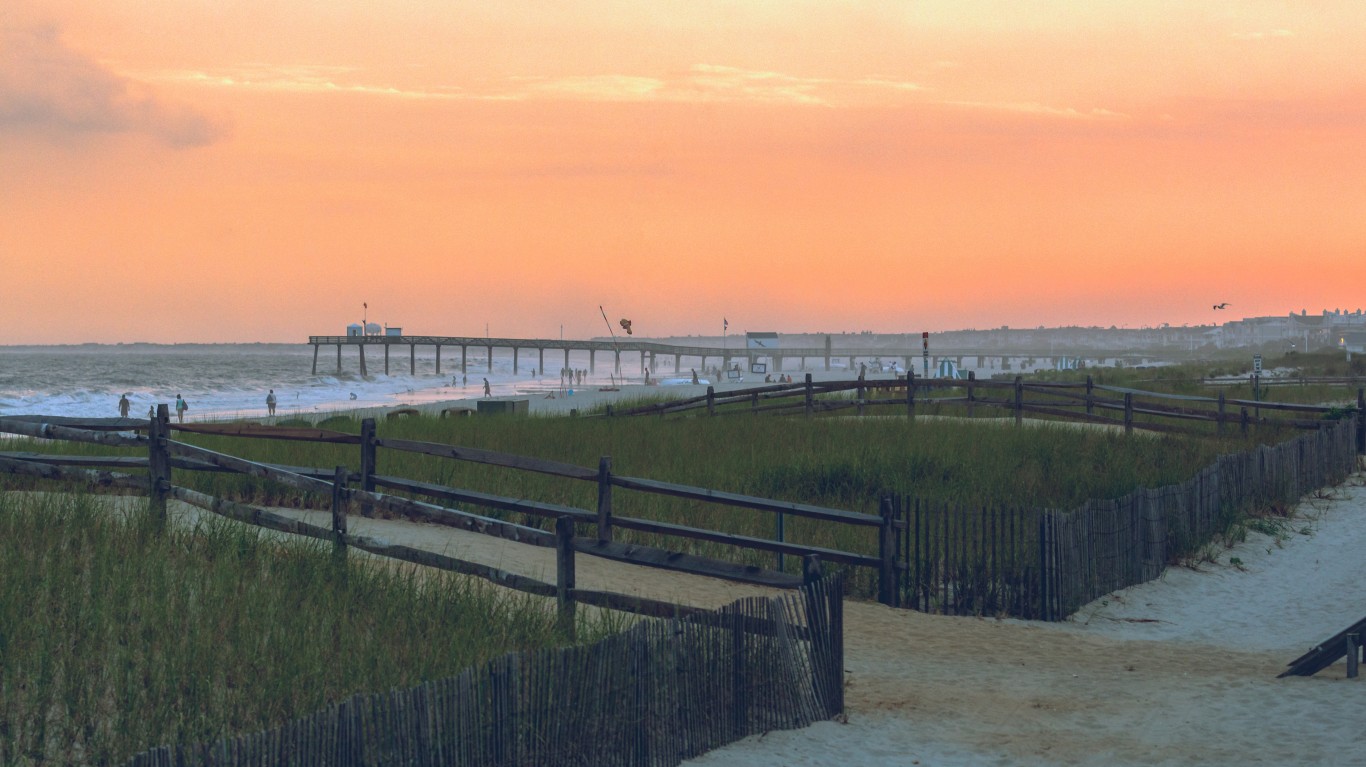
4. Ocean City, NJ
> Pct. of workers in high-risk industries: 29.1%
> Businesses with fewer than 50 employees: 3,780
> COVID-19 cases as of May 6, 2020: 369 (393.8 per 100,000)
> Statewide stay-at-home order enacted: March 21, 2020
> Status of stay-at-home order as of May 6, 2020: In place
> Population: 92,560
Located along the New Jersey coast, Ocean City is one of the most tourism-dependent economies in the United States. Some 28.3% of workers are employed in leisure and hospitality, the fourth largest share of any U.S. metro area. With gatherings prohibited, restaurants open for takeout and delivery only, and a statewide stay-at-home order in effect since March 21, New Jersey currently has some of the strictest stay-at-home measures of any state, which is likely hampering consumer activity throughout the area’s beaches. Many of the tourists to the area come from New York and Pennsylvania, which are under similarly strict lockdowns.
Many small businesses in Cape May will likely struggle to generate the cash needed to survive the economic downturn. An estimated 93.2% of businesses in Ocean City have fewer than 20 employees, the largest share of any metro area.
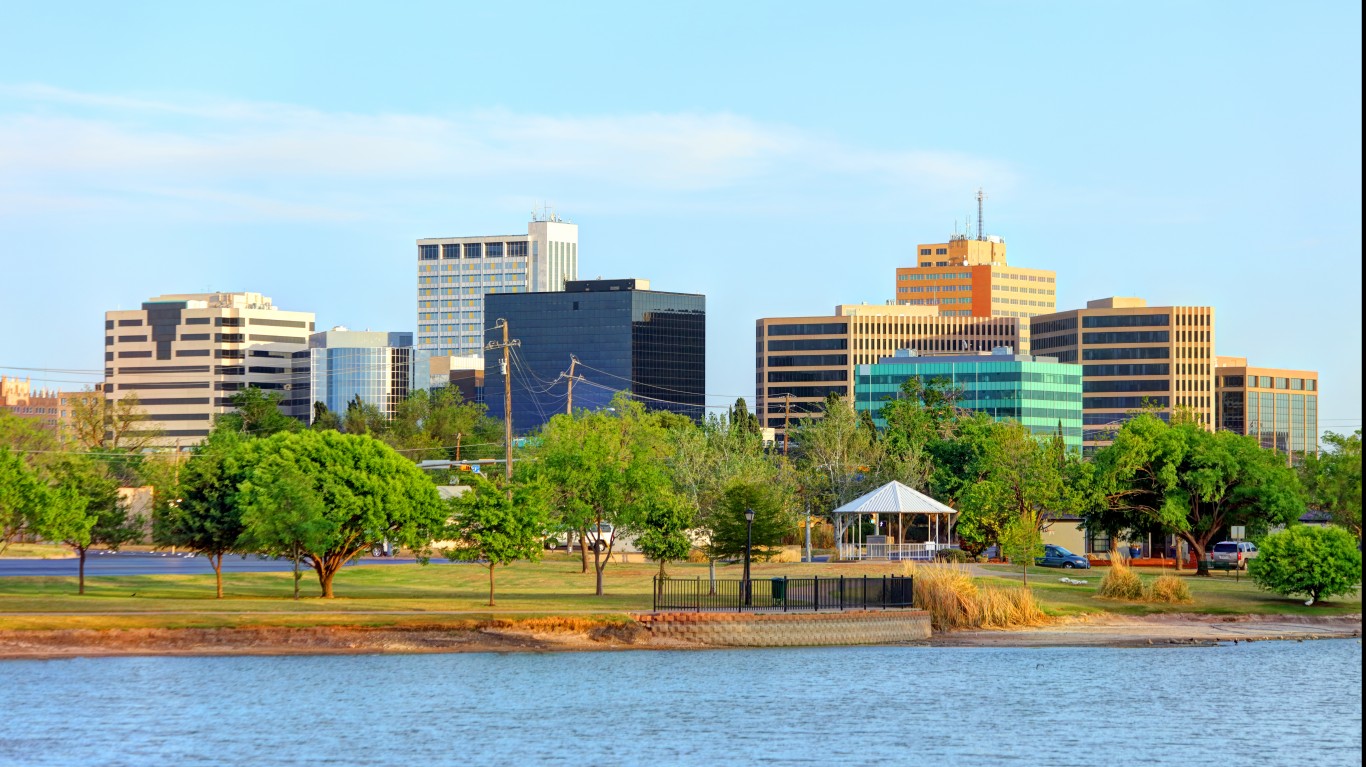
3. Midland, TX
> Pct. of workers in high-risk industries: 41.1%
> Businesses with fewer than 50 employees: 5,092
> COVID-19 cases as of May 6, 2020: 93 (54.8 per 100,000)
> Statewide stay-at-home order enacted: April 2, 2020
> Status of stay-at-home order as of May 6, 2020: Lifted
> Population: 177,218
Located in the heart of the Permian Basin — a region accounting for about one-third of U.S. oil production — Midland is one of the most energy-dependent economies in the country. Some 27.6% of workers are employed in the mining, quarrying, and oil and gas extraction sector, the largest share of any metro area.
While economists predicted oil-dependent areas would be among the hardest hit by the slowdown in overall consumer activity during the COVID-19 pandemic, few foresaw the additional fallout producers would face from the unexpected price war between Russia and Saudi Arabia that sent the price of U.S. crude oil below zero for the first time in history. Midland oil companies have since been forced to lay off hundreds of workers, with more layoffs likely coming down the pipeline as production continues to idle.
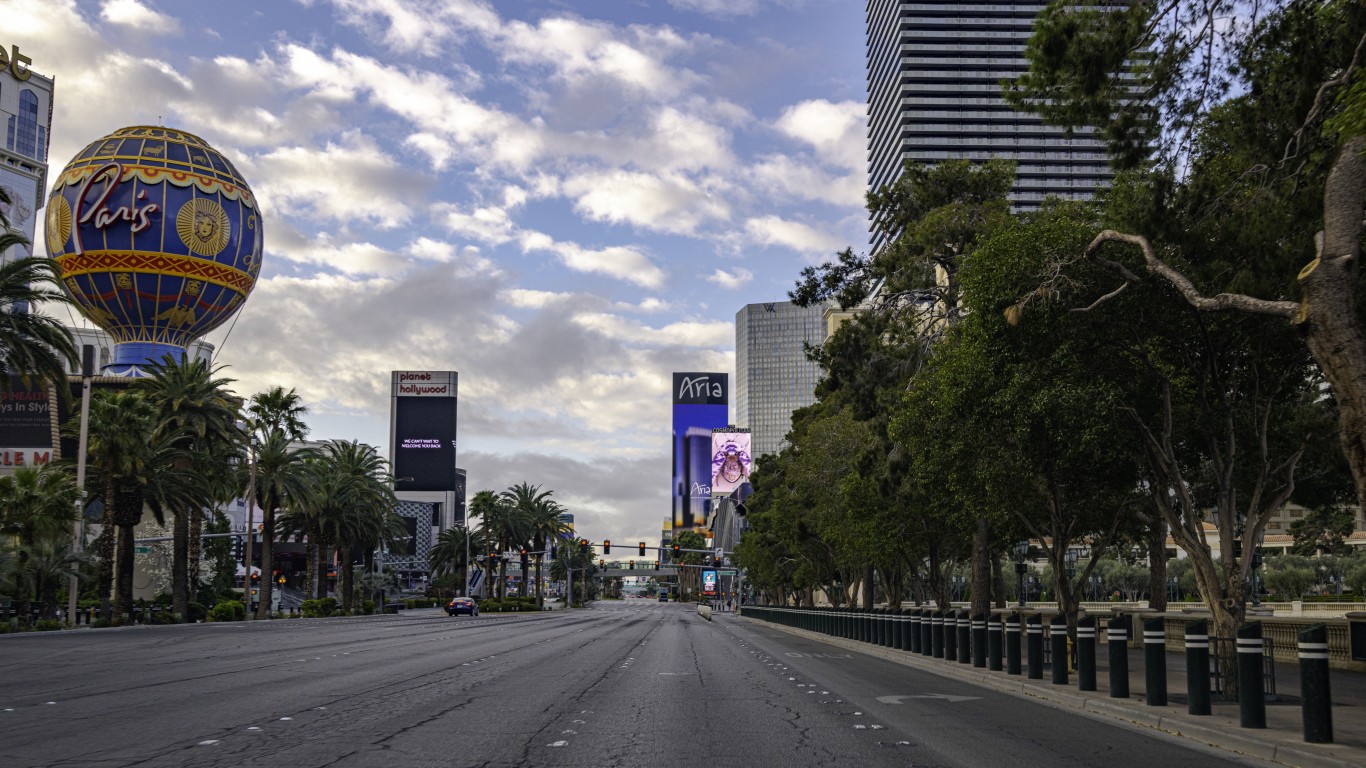
2. Las Vegas-Henderson-Paradise, NV
> Pct. of workers in high-risk industries: 35.4%
> Businesses with fewer than 50 employees: 43,095
> COVID-19 cases as of May 6, 2020: 4,408 (205.8 per 100,000)
> Statewide stay-at-home order enacted: April 1, 2020
> Status of stay-at-home order as of May 6, 2020: In place
> Population: 2.2 million
Few metro area economies are more vulnerable to the effects of a global pandemic than Las Vegas. The leisure and hospitality sector attracts over 40 million visitors every year, and employed 29.2% of the metro area’s workforce prior to the COVID-19 crisis — the third largest share of any metro area in the United States. But due to safety precautions related to the coronavirus, for the first time in recent history, the Las Vegas Strip is completely shut down.
While the economic impact of the coronavirus shutdown is hard to measure, the Nevada Resort Association has estimated that the state has lost $2 billion from cancelled meetings and conventions so far, which could lead to a total of $39 billion in lost revenue. And while unemployment data also does not capture the true impact of the pandemic, the unemployment rate in Las Vegas rose from 3.7% in February 2020 to 6.8% in March, the third largest increase of any metro area.
[in-text-ad-2]
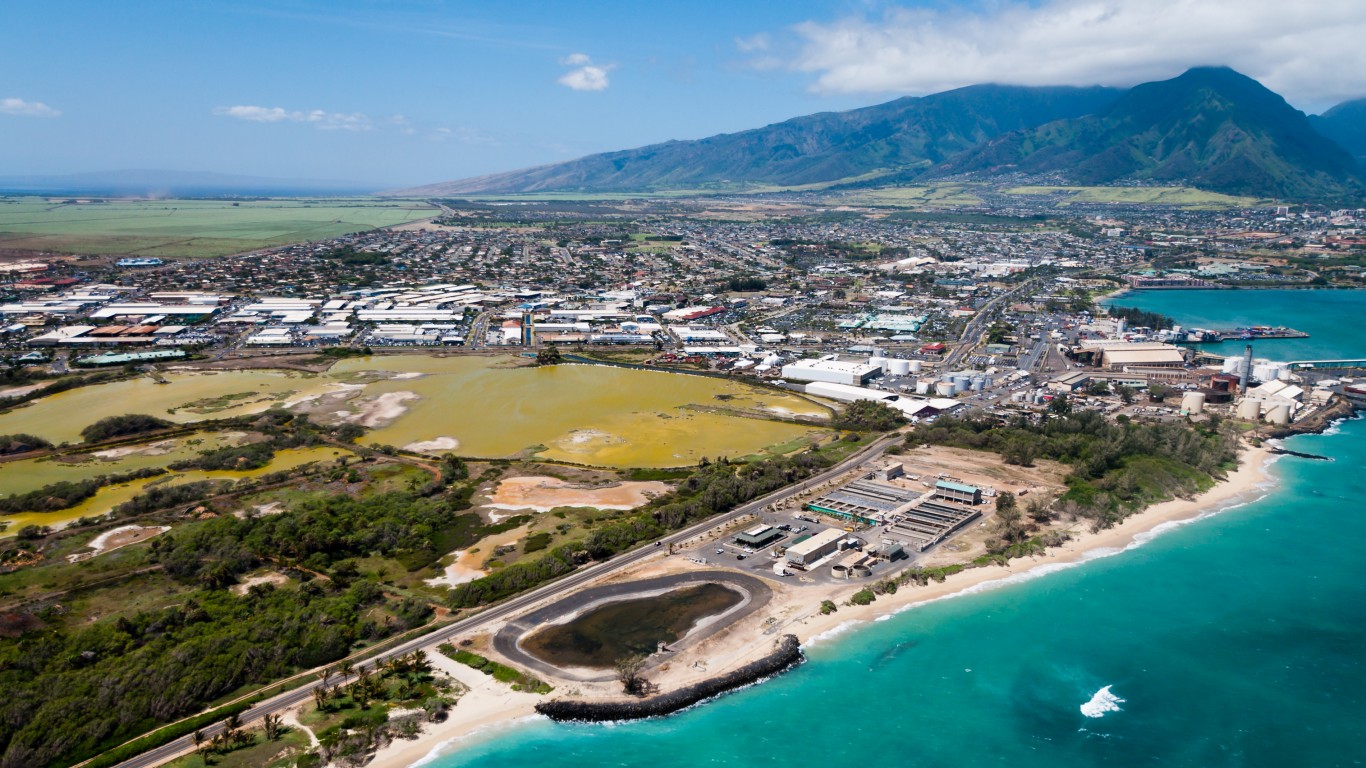
1. Kahului-Wailuku-Lahaina, HI
> Pct. of workers in high-risk industries: 40.8%
> Businesses with fewer than 50 employees: 4,476
> COVID-19 cases as of May 6, 2020: 116 (70.2 per 100,000)
> Statewide stay-at-home order enacted: March 25, 2020
> Status of stay-at-home order as of May 6, 2020: In place
> Population: 167,295
While Hawaii has been largely isolated from the worst public health effects of the coronavirus, the state is among the hardest hit by the economic fallout related to the pandemic. With travel restrictions and stay-at-home orders in place in much of the country and the rest of the world, the total number of visitors to the islands fell by over 50% in March 2020 compared to the prior year.
Kahului-Wailuku-Lahaina is poised to be particularly hard hit by the slowdown in tourist activity. Some 32.2% of workers were employed in leisure and hospitality prior to the COVID-19 crisis, the largest share of any U.S. metro area. In total, 40.8% of workers were employed in industries identified by Moody’s as high-risk, far more than the double the 17.7% national figure.
If you’re one of the over 4 Million Americans set to retire this year, you may want to pay attention.
Finding a financial advisor who puts your interest first can be the difference between a rich retirement and barely getting by, and today it’s easier than ever. SmartAsset’s free tool matches you with up to three fiduciary financial advisors that serve your area in minutes. Each advisor has been carefully vetted, and must act in your best interests. Start your search now.
Don’t waste another minute; get started right here and help your retirement dreams become a retirement reality.
Thank you for reading! Have some feedback for us?
Contact the 24/7 Wall St. editorial team.